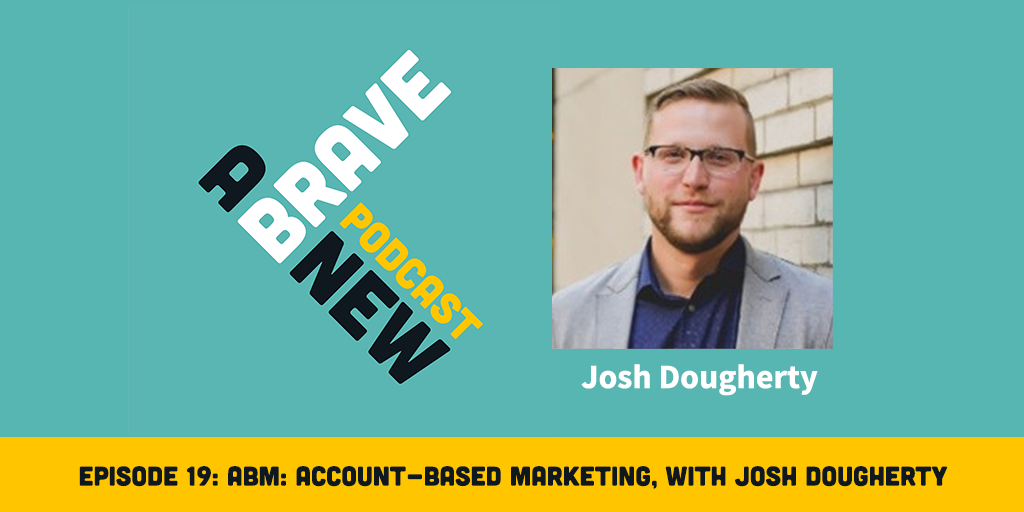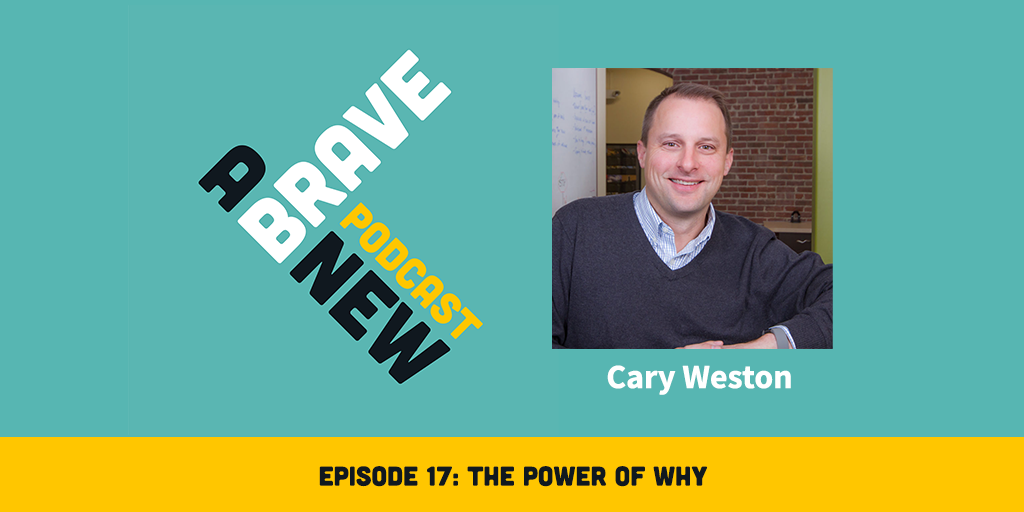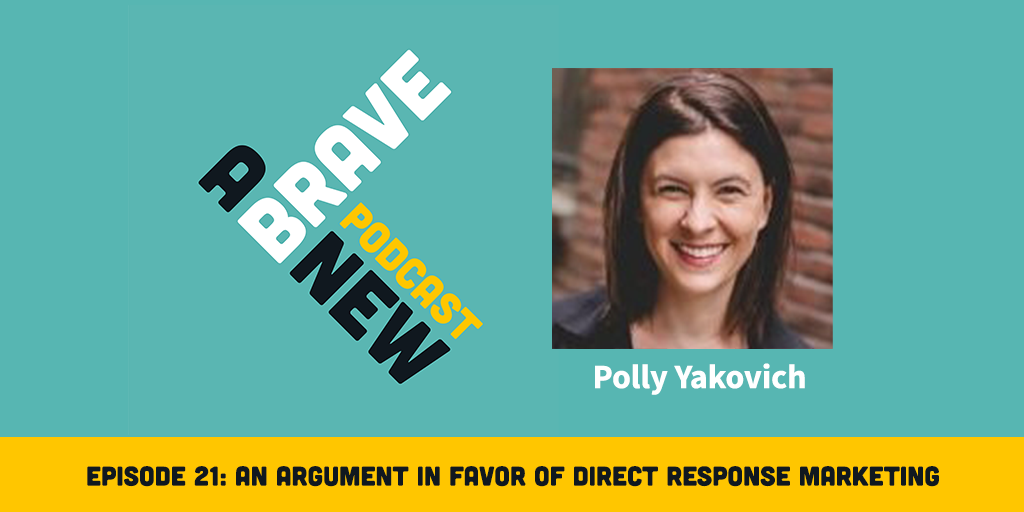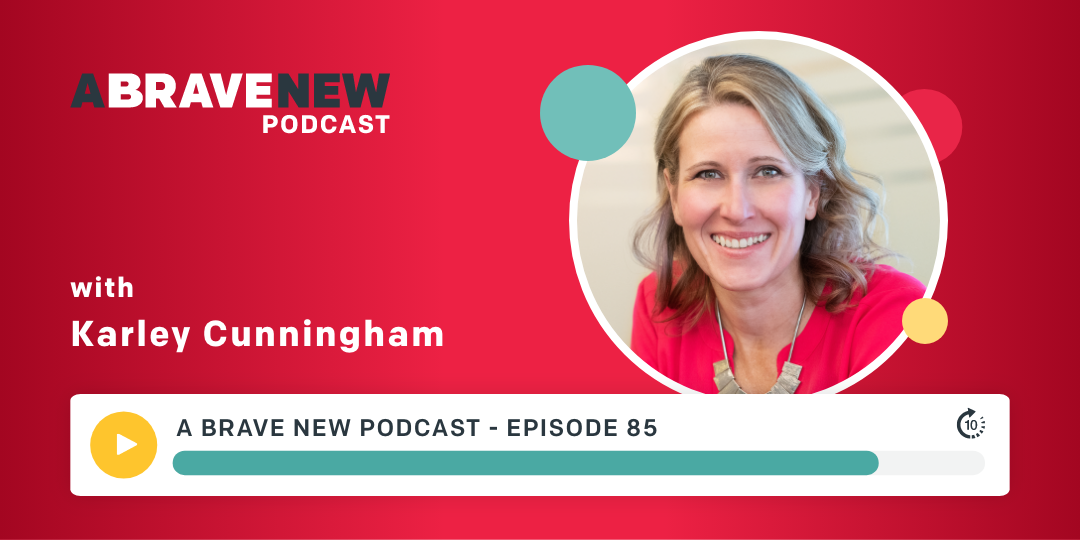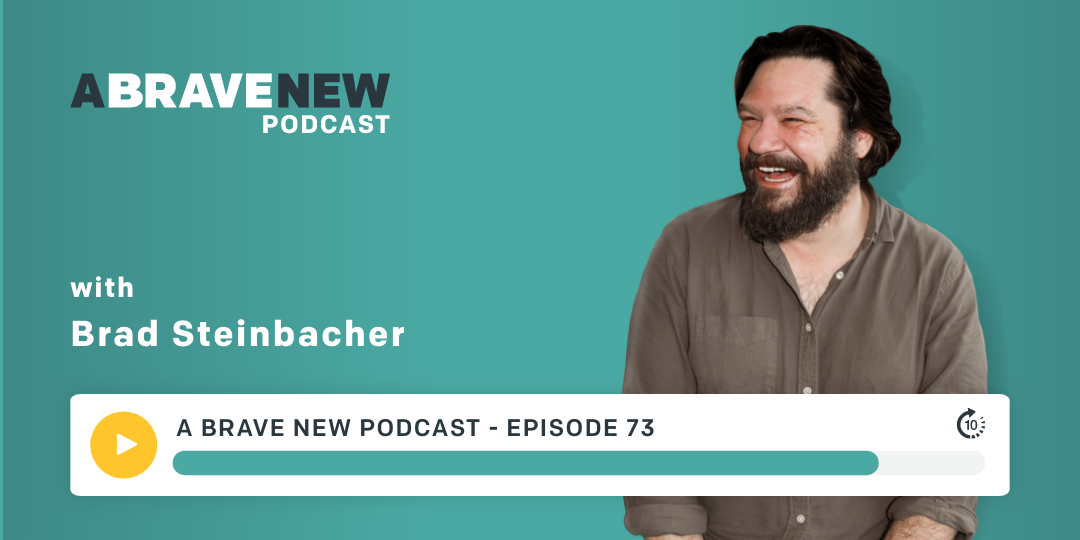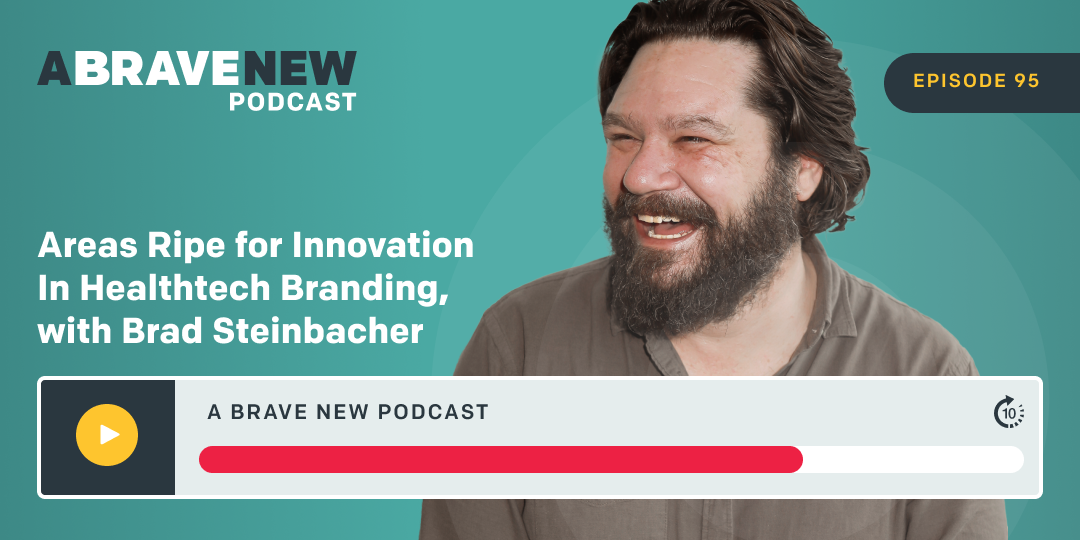.jpg?width=116&name=Josh%202020%20Headshot%20(1).jpg)
Josh Dougherty is the CEO and a co-founder of A Brave New. He specializes in working with clients to identify barriers to their growth and overcoming those barriers with strategic content and marketing tactics. He has a decade of experience in digital marketing and branding.
What you’ll learn about in this episode:
- Why there is often confusion surrounding what is and isn't branding, and why branding goes far beyond just a logo
- What a brand is, how it gets to the heart of what differentiates your company from others, and why strong branding can be a powerful thing
- Why great branding conjures specific feelings, concepts and memories in audiences, and why branding helps you break out from your competitors
- Why timing is an important factor in establishing your brand, and why A Brave New has developed an accelerated branding process
- Why your branding should be designed to last you years or even decades, and why accelerated branding can help you adapt and tweak your branding while developing it
- Why branding is about more than just marketing but should reflect the essence of your business vision and values
- How "brand filters" can help you ensure that your branding is being utilized and applied correctly and consistently throughout your messaging
- Why there is a common perception that branding can be too restrictive, and why the branding process can inspire creativity
- Why it is important to be intentional in developing your branding, and what questions to ask your leadership team to ensure that your branding is clear and effective
Resources:
- LinkedIn: www.linkedin.com/in/jdough/
Additional Resources:
- Website: www.abravenew.com
- Facebook: https://facebook.com/abravenew
- Twitter: https://twitter.com/abravenew
- LinkedIn: https://www.linkedin.com/company/a-brave-new/
Intro:
Welcome to A Brave New Podcast. The podcast all about how brave entrepreneurial companies are unlocking their business potential using inbound marketing. Here is your marketing expert and host Polly Yakovich.
Polly Yakovich:
Hi, this is Polly Yakovich. Welcome to A Brave New Podcast. I'm joined today by my co-founder and co-owner of A Brave New, Josh Dougherty.
Josh Dougherty:
Hi, how's it going?
Polly Yakovich:
Josh, can you... Seeing as this is your first time on your, essentially, very own podcast. Can you give a little bio, a little brief background for our listeners?
Josh Dougherty:
I would love to. Literally. So my background is in branding and content strategy. I've been working in marketing agencies for the last 15 years. Really focused on how do we develop messaging and content that connects really directly and with an audience which is, I think, really become super important as stuff has gotten more loud and noisy in the marketplace. And so I really liked to work with clients and help them figure out what makes them unique, what makes them stand out, and then how do we make those points of uniqueness shine in a marketing program.
Polly Yakovich:
So that works perfectly with today's topic. We wanted to talk a little bit about branding. I feel like branding is a really good topic for us to talk about. One, because you're a branding expert. So vis-a-vis your area of expertise. But also because I think branding is so often misunderstood. I hear people all the time talk about branding and they're really talking about a lot of things that we don't consider to be part of the branding process at all. So first I'd like to start by talking about what is branding? And maybe just as importantly, what isn't branding?
Josh Dougherty:
Yeah. I think it's easier to start talking about what isn't branding because that's where people tend to lead to first. I think the reason there's a lot of confusion between the different things is brands sound like this vaguely familiar term and we all think of things like Proctor and Gamble and Head and Shoulders shampoo and Clorox bleach and all these kinds of things. These are great brands. We use that term all the time and just throw it around. But at the end of the day, we don't really understand what branding is because we haven't taken the time because it seems so familiar. And so...
Polly Yakovich:
I think most people think branding is logo.
Josh Dougherty:
Yeah.
Polly Yakovich:
A cool logo or cool colors or packaging.
Josh Dougherty:
Yeah. One of the cool exercises we often do when we're starting a conversation is, and this is probably anyone who's done branding has done a similar thing, but we'll put up like a BMW and a Toyota logo up on the screen and ask people, "What do you think about when you see these two logos?" And that's like that aha moment for someone who hasn't thought about branding in-depth before to realize, "Oh, I thought it was like the logo and the colors I used in my marketing, but there's actually..." In the realm of BMW these ideas of this optimal driving machine, luxury performance, all these concepts that are nested and really behind and deeper than the logo and the logo just represents them. So that's a really good example of why something like a logo or something like a marketing tagline isn't actually the brand, it's more of an... I would say like a representation of the brand to the world.
Polly Yakovich:
So what is a brand then? What makes up a brand?
Josh Dougherty:
Yeah. So I would say a brand is that unique... and we talked about in terms of an essence. So it's the unique essence or the unique way that you do your work that no one else can kind of claim ownership over. So most people like when they talk about their mission for their company or their business, there are 20, 30, 40, in the case of a marketing agency like us, 500 other companies that have maybe the same mission. But the thing that should differentiate you is this idea of the unique way that you go about accomplishing your mission. So to kind of build upon that a little bit more, we've talked at A Brave New about how one of the key elements of our brand is this helping our clients achieve this big idea. And so we want people to have a memory of when they finish talking with us, they're like, "Oh yeah. These guys really pushed me or stretched me to think further than I was thinking about my business previously."
Josh Dougherty:
And that's us trying to put that memory of that brand essence in their mind. Another thing that we think about is it's this connecting thread that goes through everything that they do. That's all really vague. So specific examples. And again, classic branding examples would be like Harley Davidson selling this concept of freedom. So most people think that Harley sells motorcycles, but they get their real benefit of selling this concept of that I'm an office worker and I own a motorcycle so I'm a little more bad-ass than I thought I was. And I may only ride my motorcycle like 75 miles a year, but I feel like I'm free because of it.
Josh Dougherty:
Another great example, a tired example, but still like one of the best is this idea of Disney selling magic. Any interaction with Disney feels magical from the fluttering of Tinkerbell in a video or the movies from the '60s or '70s, whenever that was from, to kind of how you interact with characters at one of their parks. It's built to be a magical experience. They never talk about magic except when they call it The Magic Kingdom, but they do make sure that's infused throughout.
Polly Yakovich:
I think a lot of our clients and people that we encounter sort of feel like, "We have the logo. We have the colors. Our brand's good enough. Why would I embark on a branding process?" What are we really trying to help them with?
Josh Dougherty:
Yeah. I think really it's... The fundamental thing is the competition is increasing every year. And so I'm going to butcher these statistics a little bit, but our friends over at HubSpot talk about how like in 2017 you had six competitors that you were directly competing against frequently and today there's 17 to 20. That number is just going up. That's one reason that brand matters because if you have 17 to 20 people who are literally selling the same product as you, if you can't tell people why your product is different because of your unique approach, you're going to end up only competing on price, which is going to drive down your margins, which is going to drive down your profitability, which is going to, at the end of the day, be a zero sum game for you. I think the other piece that really is important is this concept of the democratization of media as well.
Josh Dougherty:
Social media is really broken. Like the ability for any brand to control their message. And so if you want to leverage word of mouth, which is super important today, you need to be super on-message around your brand and you need to make it something that is worth a consumer being loyal to, or a client being loyal to, because that's the only way that they're going to share your message. And any of your clients or your customers sharing your message is going to be a hundred times more valuable than your brand sharing that message.
Polly Yakovich:
So why do clients always roll their eyes when you talk about a branding project? What are some of the... I mean, I'm sure everyone out there has a lot of pain points when it comes to branding. So what are some of the common problems with a branding process? Why are clients so reluctant to embark on it?
Josh Dougherty:
I think for media, like small to midsize businesses, it feels like pouring out a bunch of money for nothing in return. I mean, how many times have we had that conversation with an exec? And they're like, "So I'm going to pay you X number of dollars. And you're going to..."
Polly Yakovich:
Go away to a cave for 18 months.
Josh Dougherty:
And give me some idea at the end that I'm...
Polly Yakovich:
Give me some esoteric, planet circling idea.
Josh Dougherty:
Yep. And then never be able to land the bus for me or land the plane. I guess, to carry out the metaphor and...
Polly Yakovich:
It doesn't feel practical.
Josh Dougherty:
Yeah. And then they're stuck.
Polly Yakovich:
Yeah.
Josh Dougherty:
So they're going to end up spending a lot of money and not having anything at the end of the day. I think the other thing is most people are operating on a really quick timeline of, "I need to see results." Regardless of the practicality, it's like even if I know I have a problem, I needed my problem solved three months ago. So how am I ever going to hang on for 24 months to get this all sorted before my revenue goes up?
Polly Yakovich:
Well, and I think both of us earlier in our careers were a part of really long branding projects. I mean, it was like what? Six months of research, six months of going away to a cave in the Himalayas and developing concepts, bringing it back. By the time that you got to something, clients were sort of done and over it. It was a year later.
Josh Dougherty:
Yeah. And the world changes before you're even launched your concept that you thought was golden [crosstalk 00:09:08]...
Polly Yakovich:
And then people are exhausted, let alone be prepared for a rollout. They were just like, "Oh, project." But you were just starting the rollout. And we typically say it takes how many years for a brand to really seed itself in their audiences?
Josh Dougherty:
I'm thinking 18 months to three years. A significant amount of time.
Polly Yakovich:
Talk a little bit about why we started doing, which is probably hearsay and apostasy to most branding experts, but why we started doing this accelerated branding process.
Josh Dougherty:
I think there's the three main benefits to it. The first is just like the element of energy. So what you talked about from implementation, that's a really real I work... Steve Brock, who's a good friend of mine, has been doing branding for 30 years, but always goes around and says he can count on one hand the number of brands that have successfully implemented after he sent a branding project. And I don't think that's any hit on him. It's just like it is hard work to stay on message.
Polly Yakovich:
For three, four years.
Josh Dougherty:
For three or four years afterwards. And so like the very... If we can get through the initial development to the implementation faster, people have more energy. That's one really real thing. Another thing is thinking about the actual brand's essence development. Obviously we want any brand to be developed to last 10 to 15 years, at least, before it needs some significant tweaking. If it's a really good, like a Disney, it should last. It should be timeless, really. It's always the essence of the company. But there is an element of opportunism in going through a branding process and looking at your competition and saying, "Where are the gaps? Where are the holes?" And the world just moves too fast today. Just look at holes at the beginning of a project. And then two months, two years later implement that gap that you thought was a real opportunity is probably going to have disappeared within the course of 24 months.
Josh Dougherty:
So that's another reason. And then the final reason is I just like testing things in real time. Most people are... If you can get to like that core idea and then worry a little bit less about having all the perfect nuance worked out and launch with something that's a really good or core idea and work in the marketplace of actually iterating on how you're talking about it to the public and to your prospects, to your potential clients. You're going to have a much better feedback loop than if you're just sitting in endless meetings trying to decide what would play best with people in the real world.
Polly Yakovich:
I think an accelerated branding process really plays to our strength, I think, as marketers as well, but we've just found, besides all the reasons that you've said, that you can get to sort of 80% of the perfection you would get to after 12 months or more in the first 90 days. And then like you're saying, get it out there in the marketplace, ship it, get it out there, learning, listen, adapt. If you have the core elements in place, you can always adapt some of the ways that it's being executed and talked about and iterate on it in a really practical way after you hear how the audience reacts, how you see it being used in reality by your team, et cetera.
Josh Dougherty:
Yeah. And I think one of the other things that goes with that is everyone's like, "But what about your throwing out acceptance testing as something that you do after you come up with your brand concept? Then I could..." I've never experienced nor have I ever heard of brand acceptance testing when someone's like, "That's a great idea for an established brand." People hate change. And so they're always going to say like, "No, I liked what was there before." And so this kind of cuts that out and it's like if you really believe that this is what you are in your essence, own it, go for it, and then figure it out.
Polly Yakovich:
Be authentic.
Josh Dougherty:
Yeah. And at the end of the day, your brand should be good enough that some people hate you. And some people love you. If everyone's like, "Oh yeah, they're pretty cool." Then your brand isn't very effective.
Polly Yakovich:
And here's the reality too, is that we said it and we've glossed over it a little bit, but it's like Steve Brock says. If only a handful of brands in his entire career doing branding pretty much sold as a practice. Well, you have a handful of brands have actually implemented successfully. One of the reasons we do an accelerated process is just to get to the implementation. Because that's where it all matters. If you have the most perfect idea and the most beautiful visuals, but you can't get it implemented, then it doesn't matter.
Josh Dougherty:
Yeah.
Polly Yakovich:
And so just being able to get to actually rolling it out and doing the disciplines of implementation that's where everything is going to repay itself
Josh Dougherty:
A hundred percent. Otherwise, why are we going to the exercise?
Polly Yakovich:
Talk to me a little bit, because I think implementation is a really interesting thing, but talk to me a little bit about the benefits and how you use the brand both internally and externally. Because we always think about brand launch and implementation as an external action, but we would typically say that it's almost more weighted in value and in execution to the internal team.
Josh Dougherty:
Yeah. I think that's another... You asked me the question at the beginning of what is branding and what isn't. I would say any branding process that only thinks about marketing is not actually branding. Branding is a way of life for an organization and so it should be impacting the services you're choosing to sell, the HR processes you have, how you manage your teams, how you're doing your marketing, and really the decisions that you're making all the way up to the executive level about what the strategic direction is of the organization. And so at least 50% of your branding effort needs to be focused on what is the experience going to be like? How's it going to be different for your staff or your team afterwards? What are the things you're going to ask them to do that are different?
Josh Dougherty:
How are we going to make it feel like they work in a special place that they want to represent in a glowing way to the people that they talk to every day? Because they're your biggest brand ambassadors, whether they're client facing in the day to day or not, they all have friends who work at other places who represent them. And so a lot of what we like to do is really focusing in on how do we influence behavior in it? And it's really tempting to get super in depth there but one of the simplest mechanisms we use is a tool called branded behaviors which is maybe identifying five things that we want to ask every staff person to do with their brand to live it out after relaunching. And it can be simple things like we just worked with a client last year who spent some time... And one of their branded behaviors was asking, "Have you thought about the brand essence as you're putting together a presentation for a client?" It's a pretty simple question, but it's pretty transformative if everyone in the organization does that.
Polly Yakovich:
I think we also talk a lot about brand filters so that as people, whether or not it's a client presentation or a new business pitch, when people are putting stuff together, that may be external communication of any sort, they're able to apply this filter and make sure that they're utilizing and consistently applying the brand.
Josh Dougherty:
Yep. And I think where people get excited about the brand filters though, to explain that a little bit, it's usually five questions that directly relate to the brand essence, so that core concept or core memory, and then the five supporting elements to that essence, forcing someone to think through, "Hey, does this represent the essence accurately? Does it represent each of the attributes of the essence accurately?" And people really get excited about that when they realize that it allows them to say no to things too. Because we've all been in that experience. I mean I'm probably doing this all the time with my team and our team where we're saying, "What about this random idea that we should do?" And if someone has a brand filter and they can come and say, "Well, Josh, this actually doesn't match up with our brand." They have the power to stand up to someone who's in a leadership position and say, "No, we shouldn't do this because X, Y, Z. Not just because I don't want to do it." Which is a powerful tool.
Polly Yakovich:
Yeah. That's great. What's the less sexy side of brand? I think there's obviously a lot of cache and notoriety that comes from being a logo and a color creator. But what's like sort of the nuts and bolts. What are the foundational aspects of the brand that...
Josh Dougherty:
Yeah. I think something that is... The development process is always pretty sexy. I mean, you're coming up with a new concept. You're developing something that looks cool. You're coming up with a couple of bits of messaging that sound really memorable. And that is always a lot of fun. I think the implementation is never sexy. I mean, if you could...
Polly Yakovich:
Because it's discipline.
Josh Dougherty:
It's discipline and it's just about doing the same thing over and over again.
Polly Yakovich:
And it's like the old marketing adage that is still true and always will be true, that when you have said it enough that you're sick of it and like vomiting out because you've said the same thing forever, that's when your audience-
Josh Dougherty:
You might be making...
Polly Yakovich:
... Just start to pick up on it, maybe.
Josh Dougherty:
Yeah. You might be making some progress at all.
Polly Yakovich:
Yeah.
Josh Dougherty:
Yeah. So I think the less sexy thing is like when I have to go to a copywriter and say, "Did you look at the brand platform, the messaging platform?" For the 50th time. Because if I'm reviewing copy... And I say that almost every time I review copy. And that's not fun. The other thing is saying no to new ideas. There's always a cool campaigns that could come up. And my recommendation to anyone who is implementing a new brand is say no to all the cool campaigns for three years and just talk about your brand essence. And no one wants to hear that because most of us got into marketing because we like fun ideas. We like new things. We like to move quick and this feels like I'm moving super slow. But the investment for your company three years down the road, five years down the road, 10 years down the road is significant value if you can actually follow through.
Polly Yakovich:
Which leads me to my other thought which is that, branding is really fun and sexy on the front but I think a lot of people resist it because they feel like it's going to be too restrictive for them.
Josh Dougherty:
Mm-hmm (affirmative).
Polly Yakovich:
Talk about that just for a minute.
Josh Dougherty:
Well, I think people think if there's one thing that I do in one unique way, I do it. No one's going to want to listen to me. We're going to run out of things to say. And I think that is really a confusion between what a brand is and what a marketing vehicle is. Because at the end of the day when... I'll keep talking about Disney's magic concept. It's easy to talk about. But like they happen to have something that really represents well in real life, but they intentionally only use it in very sparing instances. And then they're coming up with marketing campaigns that convey this idea of magic throughout. So I think it really becomes a vehicle for creativity around an actual concept that has some grounding as opposed to a limiting factor.
Polly Yakovich:
It's one of those great conundrums that there is freedom and restriction?
Josh Dougherty:
Yeah.
Polly Yakovich:
Right? I think we all learn this with our children but it's hard to apply it to ourselves.
Josh Dougherty:
And that's the reality that you're never starting from a blank slate if you have a real brand. Like any creative struggle, like early in my career when I was a copywriter and I had something completely like the blank page I couldn't get it done. But if I'm starting from I know I need to talk about X, Y, and Z, I can come up with something super creative off of that.
Polly Yakovich:
That's amazing. So as a takeaway for our audience... Really, what do we want them to come away from today's episode? I think for me, part of it is that you need a brand. You need a differentiated brand, particularly if you're in a saturated marketplace, about who you are and why you work the way you work. So that people can develop trust with you and rapport and there's a reason for you to stand out.
Josh Dougherty:
I think even more than that, it's the point that you have a brand because your brand ultimately exists in the mind of your customers. And if you're not being intentional about it, you're leaving it all up to them to decide who you are. That's one takeaway. And then the other takeaway I would say is you should sit back, and maybe you could do this with your leadership team, and see if you guys can answer the question, independently, what makes us unique? And what... Do you guys all come back together and what is the answer? If you come back with five different answers, you probably need a branding process because if those people who are the closest to the core of the brand can't answer in the same way, then you're in trouble because your customers are in no way going to be on the same page.
Polly Yakovich:
And I would say last just to empower people that the branding process doesn't have to cost $300,000 and last three years. You're going to need necessary components. You're going to need audience research. You're going to need to develop the core component besides a logo and colors. But you can do that in a shorter timeframe and rollout something that's going to be really impactful for your business. So don't leave something up to chance that you could actually take on and bite off.
Josh Dougherty:
Dang, you can be really aggressive. Last year we, for a tech company, we redid their brand in nine weeks.
Polly Yakovich:
That was crazy.
Josh Dougherty:
That was crazy. I wouldn't recommend it, but it's possible. I mean, six months is definitely doable. It's like the norm for the work we do.
Polly Yakovich:
Yeah. So Josh, thank you so much for joining me. I know you'll be back again, but tell people who want to learn more from your wisdom where they can find you.
Josh Dougherty:
You can find me on LinkedIn/doughj D-O-U-G-H-J. That's probably the best place. Or you can always run along to the bravenew.com blog. I write a couple articles a month there. You can connect to me via social media from the website as well.
Polly Yakovich:
Great. Thanks so much.
Outro:
Thanks for listening to this episode of A Brave New Podcast. Go to a bravenew.com for more resources and advice. If you enjoyed this episode, show us some love by subscribing, rating, and reviewing A Brave New Podcast wherever you listen to your podcasts.
Similar Articles
OCT 11, 2021

The Beginner’s Guide to Generating Inbound Leads
Marketing doesn’t have to be painfully intrusive, like getting yet another telemarketing call right when you sit down to dinner with your family.
OCT 11, 2021

The Beginner’s Guide to Generating Inbound Leads
Marketing doesn’t have to be painfully intrusive, like getting yet another telemarketing call right when you sit down to dinner with your family.

